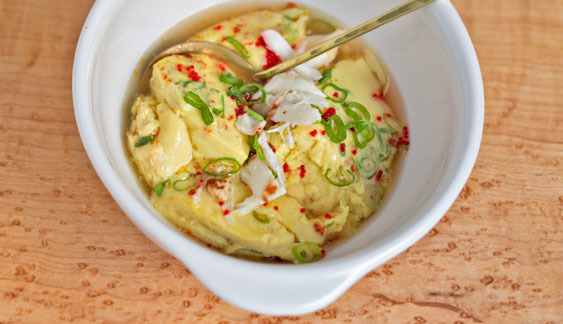Gyeranjjim (Korean Steamed Eggs)

introduction
Imagine the lightest, slippery-est quiche filling, free of dairy drag or the shackles of crust. Now inflect that filling with complex flavors from Asia—fish sauce, soy sauce, toasted sesame oil, hot chile flakes, bright scallions—and the reassuring depth of homemade chicken stock. The result: a captivating culinary paradox, ephemerally light and substantially flavored at the same time. Spooned alongside plain rice grits, moistened with an extra touch of broth, and sprinkled with fresh crabmeat or flying fish roe, the result is close to a light meal masterwork. For an extra spritz-y dimension, we highly recommend our Mak Kimchee as accompaniment.
Cooking Remarks
The quality of the eggs is central to the outcome of this dish, and we don’t mean gauging age by the sell-by or even the Julian date. We mean eggs from nearby chickens that have never met refrigeration. Given the number of households raising chickens for eggs (hey, Brooklyn!), it can’t be that much of a stretch. Homemade chicken stock is also essential.
There are all manner of recipes afoot for gyeranjjim. Cook the eggs over direct heat and give them a stir or two and the results are a fluffy, soft, tofulike curd suspended in chicken stock. Delicious, no question, but more elegant we think is the pure custard that results when the eggs are steamed in a double boiler.
Rig a double boiler by choosing an attractive 1-quart bowl that fits snugly into a medium saucepan. This way, after steaming the eggs you have an automatic serving vessel.
Rather than cook the eggs in a double boiler, you can try a bain marie and a traditional Korean cooking vessel. Pour the mixture into a 1-quart (or 6½-inch) ddukbaegi, or Korean earthenware pot (that doubles as a serving bowl), ideally one with a lid. Place a folding steamer basket in a large Dutch oven, set the egg-filled ddukbaegi on the steamer, and pour enough water into the Dutch oven to come up about one-third of the way up the sides up ddukbaegi. Be sure to cover both the inner and outer pots. Keep the water at a very gentle simmer throughout cooking (the cooking time is the same as in the recipe below).
equipment mise en place
For this recipe, you will need a small saucepan, a 1-quart liquid measuring cup, a large bowl, a whisk, a mesh strainer, a 1-quart heatproof ceramic bowl that fits snugly on top of a medium saucepan, and a medium saucepan.
-
-
2
-
½teaspoon fine sea salt
-
5large eggs
-
2teaspoons fish sauce
-
2teaspoons soy sauce
-
½teaspoon Korean red pepper flakes (gochugaru), plus additional for garnish
-
1bunch scallions, trimmed
-
1recipe No-Peek Carolina Gold Rice Middlins, freshly cooked and hot
-
Toasted sesame oil, for garnish
-
Mak Kimchi, for serving
-
-
In a small saucepan, bring the stock to a simmer over medium-high heat. Remove from the heat and stir in the salt. Pour 1½ cups of the stock into a 1-quart liquid measuring cup. Cover the pan and set aside.
-
In a large bowl, whisk together the eggs, fish sauce, and soy sauce. Slowly whisk the 1½ cups of hot chicken stock into the eggs, and then set a mesh strainer over the empty measuring cup. Pour the egg mixture through the strainer to remove any lumps. Stir in the red pepper flakes. Chop half of the scallions and stir them into the egg mixture, and then pour the mixture into a 1-quart heatproof ceramic bowl that fits snugly on top of a medium saucepan. Fill the saucepan with 2 to 3 inches of water and set the bowl on top. Cover the bowl with a tight-fitting lid or aluminum foil and set the pan over high heat. As soon as you hear the water bubbling, reduce the heat to keep a simmer, but no higher. Cook until the custard is shiny, slightly poofed, and slightly jiggly but a paring knife inserted in the center tests clean, about 20 minutes.
-
Carefully remove the saucepan from the heat, uncover the bowl, and let the custard rest over the water bath for 5 minutes. Meanwhile, warm the reserved chicken stock over medium heat until hot. Chop the remaining scallions.
-
To serve, portion the hot rice middlins into 4 individual bowls. Spoon gyeranjjim over the rice and ladle a tablespoon or two of the hot stock into each bowl. Sprinkle with chopped scallions and additional red pepper flakes and drizzle each portion with 1 teaspoon of toasted sesame oil. Pass kimchi separately.